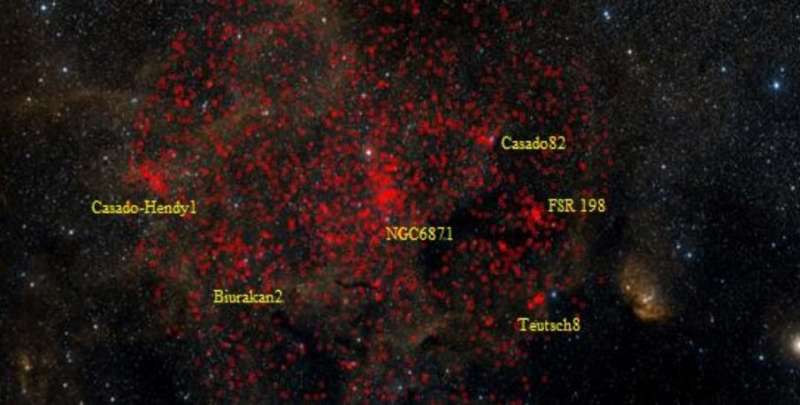
By analyzing the data from ESA’s Gaia satellite, astronomers have detected two new young open clusters. The newfound clusters, designated Casado 82 and Casado-Hendy 1, are located in a nearby primordial group of open clusters. The finding is reported in a paper published November 23 on arXiv.org.
Open clusters (OCs), formed from the same giant molecular cloud, are groups of stars loosely gravitationally bound to each other. So far, more than 1,000 of them have been discovered in the Milky Way, and scientists are still looking for more, hoping to find a variety of these stellar groupings. Expanding the list of known galactic open clusters and studying them in detail could be crucial for improving our understanding of the formation and evolution of our galaxy.
At a distance of about 5,900 light years, NGC 6871 is a young, large, and rich OC with some substructure and at least two cores. Previous observations of this cluster have found that it is part of the HC primordial group of OCs—a star-forming complex containing several young OCs, including Teutsch 8, FSR 198 and Biurakan 2.
Recently, a team of astronomers led by Juan Casado of the Autonomous University of Barcelona, Spain, has investigated this primordial group of OCs by analyzing the data from Gaia’s Data Release 3 (DR3), in order to shed more light on its properties. As part of this study, they discovered two new OCs.
“The initial objective of the present work was to revisit the primordial group of NGC 6871 in order to take advantage of Gaia DR3 results to obtain a better characterization of this star formation complex and the individual component clusters. While doing so, we have identified two new OCs (Casado 82 and Casado-Hendy 1) that we characterize in detail,” the researchers explained.
The two new OCs contain 39 member stars each and are located some 6,200 light years away. Their radial velocities were measured to be around -23 km/s. The radii of Casado 82 and Casado-Hendy 1 were calculated to be 9 and 8.1 arcminutes, respectively.
The study found that Casado 82 is approximately 6.6 million years old, while Casado-Hendy 1 is about 300,000 years younger. The total mass of Casado 82 was estimated to be 85 solar masses, which is some eight solar masses less than in the case of Casado-Hendy 1.
When it comes to metal abundances, the results indicate that they are very similar for the two OCs—at a level of 0.015 and 0.017 for Casado 82 and Casado-Hendy 1, respectively. It was noted that these values are close to that of the sun and also suggest a similar composition of the two clusters.
Moreover, the research found that all the members of the HC primordial group that contains Casado 82 and Casado-Hendy 1 have been born in the same star formation complex. The results also show that NGC 6871 seems to be disintegrating, and the primordial group members appear to be dispersing out rapidly.
Summing up the findings, the authors of the paper noted that the detection of Casado 82 and Casado-Hendy 1 suggests that many more new OCs may be discovered in the near future by analyzing the Gaia data.
More information:
Juan Casado et al, Discovery and description of two young open clusters in the primordial group of NGC 6871, arXiv (2022). DOI: 10.48550/arxiv.2211.12843
Journal information:
arXiv
© 2022 Science X Network
Two new young open clusters discovered (2022, November 30)
retrieved 1 December 2022
from https://phys.org/news/2022-11-young-clusters.html
part may be reproduced without the written permission. The content is provided for information purposes only.